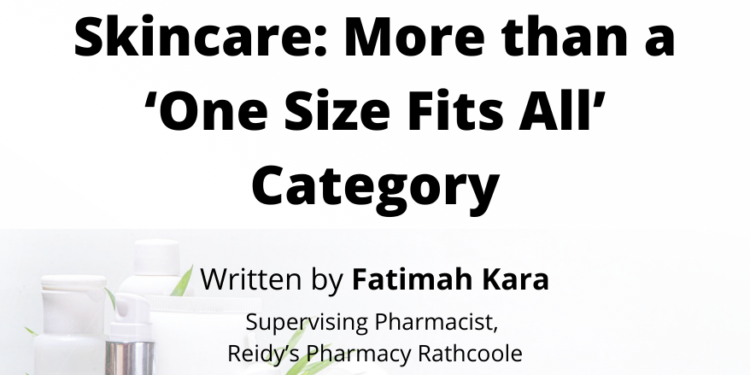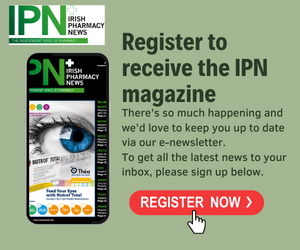The skincare category is one that has significantly grown over the past few years and continues to do so. It has evolved and has become much more than a ‘one size fits all’ approach as targeted products for specific skin types and conditions have come onto the market.

Consumers are now more equipped with easily accessible resources to determine which products and brands are best suited for them with detailed product information and reviews readily available at their fingertips to help them make informed decisions or to come to the pharmacy to ask for advice on what they have researched.
We have seen in the pharmacy a huge growth in the range of products that are at our disposal to stock to ensure a wide variety to choose from to ensure personalised advice and care to consumers.
We have noticed that consumers buying habits have changed dramatically with the emergence of brands that are more affordable there has been an upsurge in the demand for complete skincare routines. Whereas before, we would have seen the sales of cleansers and toners be the most popular items for the face, now we have a lot of consumers wanting to expand their routines to include serums, eye creams and separate day moisturisers with included SPF and night moisturisers. And with regards to the body, a lot of consumers are moving away from general moisturisers and want specific, long-acting creams, lotions, and gels.
With the rise in the popularity of social media accounts that specifically post about make up and skincare we have seen a lot of younger consumers especially teenagers ask us for certain products they have seen e.g. to help with acne prone skin. They are more willing to engage with staff and have a consultation regarding which products are best for them, they are more aware of the importance of daily skincare routines and not just a ‘quick fix’ of a cream or gel that may prove harsh on their skin and which could dry and disturb the natural moisture balance of their skin which is still delicate.
Even with the rise of social media, it has not dampened down the significance of tv advertising campaigns and features on chat shows. These continue to contribute to the success of the skincare category, particularly in the older age groups. These ads and features highlight that our skin needs change throughout the years and that it is necessary to continually assess our needs and change our routines if need be.
Online tools and new diagnostic technology in stores have helped consumers understand their specific skin type and make informed decisions and create awareness that skin requirements differ from person to person and that specific areas of the face can be different e.g. some can be oily around the t-zone and other areas might be dry and that a combination of products is not unusual.
We have noticed that shopper trends tend to change with the launch of new products or brands and from season to season. Once we receive mailings from companies about new product launches, we access how such products are doing in our pharmacy and if there will be a demand for them. For example, our pharmacy sees a lot of demand for moisturising lotions that can be used for all the family from children to adults that require once or twice daily applications. We also see a demand for anti-blemish products that are not too harsh on the skin so when new products are launched we will order them and ensure all staff members have researched and learned about them to be in a position to greatly help consumers make informed decisions regarding their skincare as we like to encourage a proactive approach for consumers regarding their health and skincare needs.
The overall value of the skincare category to the pharmacy has been invaluable, it is one, if not our best-selling category with repeat sales very common and going from strength to strength. As before, the emergence of brands that are very competitive price wise and in terms of reputation as providing skincare of the highest standard have helped to excel the skincare category. The wide variety of choice with regards to targeted products, non-perfumed and hypoallergenic and all price points has greatly improved consumer confidence in the category and continues to do so.

There has been huge innovation in the category over the years. Various formulations of cleansers ranging from hydrating to foaming to oil cleansers ensure that the skins natural balance is not disrupted. Also new cleansers which help smooth and soften bumpy skin without harshly stripping the skin of its natural barrier have been very unique and popular. Also, the innovation of gel creams and non-greasy formulations have proved very popular as they provide long acting moisture and relief and soothing hydration.
It has been very exciting personally to see how a range of products for a particular skin type e.g. rosacea can have a wide range of products ranging from cleansers right up to serums and soothing gels. This has greatly helped both staff and consumers alike to make decisions and add to their skincare routines, e.g. if we know that a product from the range is particularly effective, then we can easily find a product in the same range to compliment and aid the specific need of the consumer to help build a skincare routine that is personalised and targeted to the consumer. This has led to greater trust and uptake of the category.
The wide range of products now targeted for all ages from birth upwards is great, in the past it would have just been the original emollients such as Silcock’s Base, Aqueous Cream and Emulsifying Ointment, we now have well known, established brands branching out and providing products that are suitable for infants providing great choice and variety.
The only thing holding back the category would probably be the unwillingness of consumers to try alternative brands once they are established on a certain brand. Although not a significant disadvantage, as brand loyalty is high and continues to drive the category, I feel like it would be beneficial for consumers to understand and try different brands which might be better suited to them. However, I am aware that this can be quite costly but instore leaflets highlighting the various products in the different ranges rather than brands relying solely on their information being all online would help particularly in the older age groups and make the information more accessible.
Another thing that I have noticed is that there seems to be a lack of diversity in the target consumers of these products. There are hardly any advertisements which include men for example and thus have noticed less of an uptake in this group. The only time I see men looking for certain products is after they have been recommended by specialists, however I feel more can be done to make skincare accessible to all and to show that it is not excluded to any certain demographic.
It would be great if representatives from skincare brands came to the pharmacy for even half a day to engage with consumers and provide consultations and information about the range and types of products available.
From our pharmacy’s point of view, whenever we see prescriptions for skin conditions we will engage with the patient and offer advice on complimentary products such as creams or washes that may be of benefit and we provide samples if available.
The only risks that may be present in the category would be if consumers continue to use a product that may not be best suited for them e.g. a product that could be drying out their skin too much or are self-managing a condition which may need to be seen by their GP or a specialist. Thus it is important to engage with consumers to provide the best and most accurate advice especially those in higher risk groups e.g. diabetics.
In the majority of cases, the consumer holds the power in the category; they will come to the pharmacy knowing exactly what they want or what type of product they are looking for. However, we encourage some sort of consultation or conversation with the consumer to ensure optimal benefits are obtained from their skincare routine regardless of if the consumer knows what they are looking for or not. This proactive and dynamic approach has proved to be quite effective in our pharmacy.
There are little incentives which have improved revenue in the pharmacy such as free gifts with purchase or special offer bundles where a free cream is given when a cleanser is purchased. Quite often, these have resulted in consumers coming back to buy the free product as they have found it effective. I would personally love to see more shelf talkers which highlight what each range specifically targets as I believe these will help consumers engage with ranges that they might be unaware of or even to ask for advice on a product that interest them. More instore promotional material would also increase revenue as I have found that our window displays help spark interest in a particular brand. However, overall, revenue in the skincare category is at an all-time high and continues to grow from strength to strength. As with other categories in the pharmacy, staff training and ensuring knowledge on the category is up to date and of a high standard is crucial to aid consumers and ensure their needs are met accurately and that usage and interest in the category will continue to be high ensuring that the skincare category is very valuable in pharmacy.
View the August IPN magazine here
To recieve the monthly IPN magazine, click here









